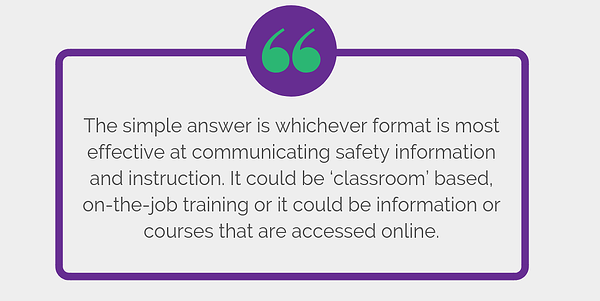For a fieldworker to operate safely, they must be able to identify potential hazards and to work in ways which minimise risks. This requires effective training and a commitment to safety that goes beyond the basic legal duties.
Minimising accidents and protecting workers welfare is a basic requirement for an efficient and reliable field services operation. Safety training plays a vital role in creating a workforce in which best safety practices are part of the culture.
But training can also be a daunting area to tackle - one where the consequences of failure have the potential to be fatal.

Here’s a look at what’s required and some tips on the best way to approach safety training:
- What are the legal training requirements
- Who should receive safety training
- What format should training take
- How often should training take place
- Do you need a safety training plan
What are the legal training requirements?
For UK businesses, there’s a whole range of different laws and regulations which cover safety training, including industry specific legislation. But the main responsibilities are set out in the Health and Safety at Work Act 1974 - this requires employers to provide whatever training and supervision is required to ensure, ‘so far is reasonably practicable’, the health and safety of employees.
The ‘reasonably practicable’ term means balancing the level of risks against the measures that are needed to control those risks, in terms of money, time and general inconvenience. The training options available to companies have been expanded by the online methods.
There’s also training legislation contained in the Safety Representative and Safety Committees Regulations 1977 and the Health and Safety Regulations Act 1996. These require that employers consult with workers, or their representatives, on safety issues - including training.
It also sets out a legal obligation to ensure that health and safety training is paid for by the employer and is organised within normal working hours.
Who should receive safety training?
The legal safety responsibility applies to anyone who is working for, or on behalf of, a business. This includes managers, line managers, employees and any contractors or self-employed workers. It covers anyone that’s operating under your organisation’s control and instruction.
More information about safety responsibilities for contractors can be found here.
What format should training take?

Or it could be any variation of these methods.
Legally, you’re required to have access to a competent health and safety advice. So, if there’s sufficient knowledge within a business, training can be handled internally. If not, external help needs to be sought to provide the required level of knowledge and expertise.
The methods used should be constantly under review, using feedback from managers and field workers to gauge the effectiveness of different methods. Changing formats can be a good way to keep training feeling fresh and avoid the dangers of it becoming a ‘box ticking’ exercise.
How often should training take place?
This will vary depending on the nature of the work but a general rule is to approach training as a process rather than an event. It needs to be integrated into work processes with systems to ensure the monitor the effectiveness of training?
The initial priority is to ensure that training is able to handle the evolving nature of a workforce. Target areas are likely to include:
-
New starters and inexperienced workers
-
Employees changing jobs/working practices
-
Employees encountering new work environments
-
Employees using new equipment
-
Safety representative
Accurate records needs to be kept of who has received training. These can be used to determine when it’s appropriate for fieldworkers to receive ‘refreshers’. It’s also important to revise and update training to ensure it reflects the latest legislation and safety guidance.
Do you need a safety training plan?
It’s not a legal requirement but it’s advised to have a plan in place to identify training needs, to create a set of priorities and to build training into your business plans.
The Health and Safety Executive advise organisations to follow a five step approach when creating a training plan. This involves:
Step 1: Identify training needs
What are the potential hazards and what skills/knowledge is required to minimise risks?
Step 2: Decide on training priorities
What are your legal training requirements and which areas pose the greatest risks?
Step 3: Choose training methods and resources
What are the most effective training methods and resources for your workforce?
Step 4: Training delivery
Make sure training processes are scheduled, managed and monitored.
Step 5: Review and revise
Are employees working as they’ve been trained? What improvements can be made?

